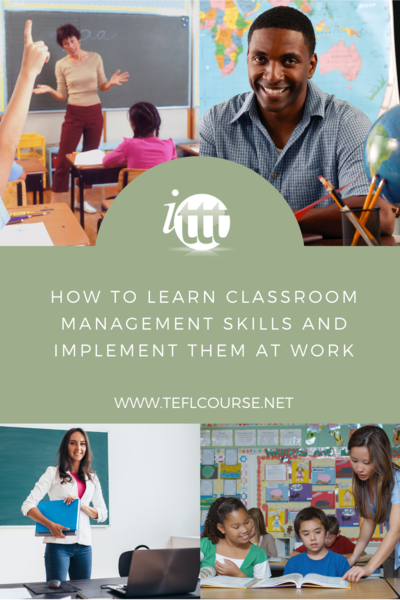How to Learn Classroom Management Skills and Implement Them at Work

Classroom management deals with role flexibility, organizing and maintaining discipline. The student's confidence and learning effectiveness will depend on the teacher's classroom management skills. The teacher must know when it is time to be firm or when to leave students alone. The level of firmness depends on the age of the students. Overall, it is best to keep a controlled environment at the beginning then tail it off with a relaxed environment especially with kids or younger learners.
Table of Contents
Do you want to teach English abroad? Take a TEFL course!
This post was written by our TEFL certification graduate Victoria G. Please note that this blog post might not necessarily represent the beliefs or opinions of ITTT.
Eye Contact
One of the disciplinary methods of classroom management is eye contact. The importance of eye contact lies in maintaining discipline, getting students involved, ensuring students understand, indicating correctness, signaling stop and start, encouraging contributions, holding the attention of students who are not being addressed and indicating who is going to speak. This will establish a good rapport with students and will make the teacher look confident. If there are issues with eye contact, the teacher will not look confident and disciplinary problems may arise in the classroom. It is helpful to know when not to use eye contact. Eye contact should be used so that the students don't feel intimidated during student-centered activities.

Also Read: How much can I earn teaching English in Costa Rica?
Grouping
Knowing how to organize students in groups is necessary for classroom management in terms of student's learning effectiveness and confidence. Grouping students in a whole class group creates a suitable environment for the teacher's control but, significantly reduces student speaking time and becomes off-putting to shy students. A student who works on his own becomes self-reliant but this method doesn't allow the student to build confidence in the classroom via student to student interaction or group belonging. Group Work can also allow students to interact and help each other but a group member may overtake the group and not allow shy students effective participation. Pair work seems to be one of the most ideal situations since confidence and learning effectiveness can grow with pairing a strong and a weak student together.
Also Read: How do I apply for a student visa to legally teach English in Spain?
Seating Arrangement
Organizing classroom seats and knowing where to sit or stand is essential to classroom management. Orderly rows will help the teacher to maintain eye contact, reduce student discipline problems, and create an effective twenty-five-plus class learning atmosphere. Separate tables will create an informal atmosphere allowing disciplinary problems to arise. Disciplinary problems arise because the students feel that they are part of a small group and not the class as a whole. The organizing of separate tables will disable the teacher in maintaining eye contact with all students. The best arrangement for small classes is the circle and horseshoe seating. The circle and horseshoe seating arrangements make the student feel that they aren't in the front or back of the classroom and will allow students to effectively focus on the lesson. This arrangement will make pair work easier and allow students to have eye contact with all other class members.
Sitting or standing (role flexibility) will affect the atmosphere in the room greatly. Situations such as language presentations and giving instructions require the teacher to stand for classroom attention. On the contrary, the teacher is preferably seated so that the students aren't distracted during reading activities, activate stages, and controlled practices. In terms of monitoring the class, the teacher should always try to let students learn effectively by not disrupting the students' flow of work during preferably seated activities.

Also Read: Interactive Whiteboard in a Young Learner's ESL Class
Teacher Talking Time
A balance of teacher and student talking time is essential to classroom management and greatly affects the student's learning effectiveness. Keeping teacher talking time to minimal levels would be beneficial for the classroom in terms of discipline and effectiveness. If a teacher talks too long then students might be bored and inclined to talk when the teacher is talking, therefore, losing respect for the teacher. The teacher should use simple language, use visual clues, check instructions and be consistent to reduce teacher talking time.
Discipline
Maintaining discipline is one of the major points of classroom management and greatly affects student learning effectiveness. To avoid problem behavior, teachers should be punctual, well prepared, fair, return homework promptly, establish rapport with students, never lose temper and never make threats that cannot be carried out. In responding to problem behavior, the teacher should act immediately so that the problem doesn't worsen. The teacher should focus on the behavior, not the student. In terms of young students, the behavior and attitude of the teacher is the most important factor in the classroom and has a major effect on discipline. If there is an attention-craving child then it is possible to make them an assistant in handing out copies or keeping the whiteboard clean. Peer pressure is also an issue that can be solved by changing seating arrangements or mixing up pairs or groups. Boredom arises amongst kids when activities last for too long and aren't varied.
Do you want to teach English abroad? Take a TEFL course!
Amongst many classroom management methods of keeping the classroom disciplined, organized and effective, classroom management has proven to be worthy of learning before teaching a class.
Apply now & get certified to teach english abroad!
Speak with an ITTT advisor today to put together your personal plan for teaching English abroad.
Send us an email or call us toll-free at 1-800-490-0531 to speak with an ITTT advisor today.
Related Articles:
- What to Watch Out for Before Signing Your TEFL Contract in China
- The 5 Best Ways to Build Rapport With Your TEFL Students
- The Best Apps to Have on Your Phone While Teaching English Abroad
- 7 Steps to Paying Off Your Student Loans While Teaching English Abroad
- 5 Reasons Why Teaching English Abroad Enhances Your Career Prospects
- Two Traveling Teachers Share What It's Like Teaching English Abroad as a Couple




